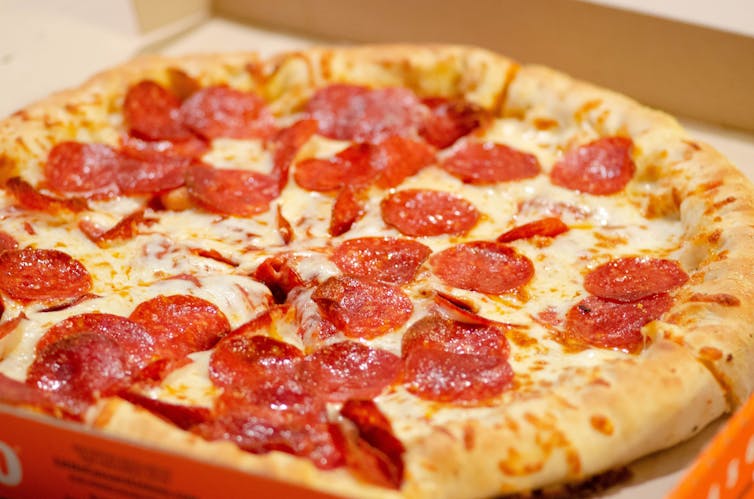If you’ve ever tried to lose weight, there’s a good chance you’ve been told it all comes down to a simple “calories in, calories out” formula: burn more calories than you consume, and the kilos will disappear.
And it’s easy to see the appeal of breaking weight loss down into simple math – just follow the formula, and you’ll achieve success. It’s also believable because many people do lose weight when they first adopt this approach.
Indeed, the diet industry’s reliance on the “calories in, calories out” concept is why society blames people for being overweight. Anyone who can’t follow this simple energy formula is only overweight because they lack the willpower to eat less and exercise more.
But the only simple truth here is that it’s time to bust the “calories in, calories out” myth as the only way to lose weight. Here’s why.
It’s nearly impossible to calculate accurately
The many calorie-counting apps and online calculators available make it seem effortless. Simply enter your sex, age, height, weight, body composition and activity levels and they’ll tell you exactly how many calories you should eat daily to lose weight.
Unfortunately, no matter how accurate these calculators claim to be, they rely on averages and can’t determine the calorie intake appropriate for you with 100% accuracy. They can only estimate.
Similarly, our metabolic rate – how much energy we burn at rest – also varies from person to person based on many factors, including body composition or how much muscle and fat we have. Complicating things further, our metabolic rate also alters when we change our diet and lose weight.

Calculating the calories in food – the other part of managing “calories in” – is also far from accurate.
While Australian food standards require foodstuffs to display Nutrition Information Panels showing energy in kilojoules, there are no requirements for information accuracy other than it must not be misleading. A worrying +/-20% discrepancy is generally accepted for the values shown on labels.
In practice, the variation can be much more than this. One Australian study found food contained anywhere between 13% less and 61% more energy or nutrient components than its packaging stated.
Not all calories are created, or consumed, equally
Another reason the simple “calories in, calories out” formula is not so simple is our bodies don’t consume every calorie the same way. What’s shown in your calorie counter is not what’s actually absorbed in your body.
Different calorie sources also have different effects on our hormones, brain response and energy expenditure, changing how we respond to and manage our food intake.
For example, while eating 180 calories worth of nuts is the same as eating 180 calories of pizza in terms of energy intake, the way these foods are absorbed and how they affect the body is very different.
While we absorb most of the calories in a slice of pizza, we don’t absorb about 20% of the calories in nuts because their fat is stored in the nut’s fibrous cell walls, which don’t break down during digestion. Nuts are also packed with fiber filling us up for longer, while a slice of pizza has us immediately reaching for another due to its low fiber content.
Our bodies disrupt the formula
The biggest failing of the “calories in, calories out” formula is it ignores that the body adjusts its control systems when calorie intake is reduced. So while the formula can support people achieving weight loss initially, the reduction in energy intake is counteracted by mechanisms that ensure lost weight is regained.
Namely, when your body registers a sustained decrease in the calories you consume, it believes its survival is threatened. So it automatically triggers a series of physiological responses to protect against the threat, reducing our metabolic rate and burning less energy.
This stems from our hunter-gatherer ancestors, whose bodies developed this response to adapt to periods of deprivation when food was scarce to protect against starvation.

Research also suggests our bodies have a “set point weight”: a genetically predetermined weight our bodies try to maintain regardless of what we eat or how much we exercise.
Our bodies protect our set point as we lose weight, managing biological signals from the brain and hormones to hold onto fat stores in preparation for future reductions in our calorie intake.
The body achieves this in several ways, all of which directly influence the “calories in, calories out” equation, including:
- Slowing our metabolism. When we reduce our calorie intake to lose weight, we lose muscle and fat. This decrease in body mass results in an expected decrease in metabolic rate, but there is a further 15% decrease in metabolism beyond what can be accounted for, further disrupting the “calories in, calories out” equation. Even after we regain lost weight our metabolism doesn’t recover. Our thyroid gland also misfires when we restrict our food intake, and fewer hormones are secreted, also changing the equation by reducing the energy we burn at rest.
- Adapting how our energy sources are used. When we reduce our energy intake and start losing weight, our body switches from using fat as its energy source to carbohydrates and holds onto its fat, resulting in less energy being burned at rest.
- Managing how our adrenal gland functions. Our adrenal gland manages the hormone cortisol, which it releases when something that stresses the body – like calorie restriction – is imposed. Excess cortisol production and its presence in our blood changes how our bodies process, store and burn fat.

Our bodies also cleverly trigger responses aimed at increasing our calorie intake to regain lost weight, including:
- Adjusting our appetite hormones. When we reduce our calorie intake and deprive our bodies of food, our hormones work differently, suppressing feelings of fullness and telling us to eat more.
- Changing how our brain functions. When our calorie intake reduces, activity in our hypothalamus – the part of the brain that regulates emotions and food intake – also reduces, decreasing our control and judgement over our food choices.
Bottom line
The “calories in, calories out” formula for weight loss success is a myth because it oversimplifies the complex process of calculating energy intake and expenditure. More importantly, it fails to consider the mechanisms our bodies trigger to counteract a reduction in energy intake.
So while you may achieve short-term weight loss following the formula, you’ll likely regain it.
What’s more, calorie counting can do more harm than good, taking the pleasure out of eating and contributing to developing an unhealthy relationship with food. That can make it even harder to achieve and maintain a healthy weight.
For long term weight loss, it’s important to follow evidence-based programs from health-care professionals and make gradual changes to your lifestyle to ensure you form habits that last a lifetime.
At the Boden Group, Charles Perkins Centre, we are studying the science of obesity and running clinical trials for weight loss. You can register for free here to express your interest.
Article written by Nick Fuller, Charles Perkins Centre Research Program Leader, University of Sydney
This article is republished from The Conversation under a Creative Commons license. Read the original article.


Malarkey. The laws of physics applies to us all. Our body attempts to compensate (hold on to calories more under some conditions than others) but the bottom line is we gain weight according to our eating habits and we lose weight according to out exercise habits. If you eat hot fudge sundaes three times per day and with no movement during the day or night you will gain weight. If you eat spinach three times per day and jog 5 miles three times per day you will lose weight. This is not some sort of voodoo, it is the law’s of physics. Calories in calories out determines your weight not how much you are breathing in and expiring out.
But why nobody raise important question: what energy conservation law have to do with mass conservation law?
I mean we could have 2 particles A and B with the same mass but different energy. This is possible.
So what if we’ll use A with less energy or B with more energy? This alone could change energy without changing mass. So even if calculations were accurate – mass doesn’t have anything to do with energy – and what more mass doesnt say if this are muscles or fat or whatever else.